In the digital age, mobile advertising has become a no-brainer for businesses that want to reach local audiences.
With the increasing use of smartphones for daily activities, consumers are expecting businesses to engage them where they are spending most of their time—on mobile.
But how can businesses make the most of mobile advertising to increase their presence locally?
This article explores proven tactics and strategies to help you make the most of mobile advertising and dominate your local market.
- Why Mobile Advertising is Essential for Local Businesses
- 4 Proven Mobile Advertising Tactics for Local Promotions
- Optimizing Your Google Ads Strategy for Local Reach
- Creative Mobile Advertising Ideas to Stand Out Locally
- Tracking and Measuring Success in Local Mobile Advertising
- Mastering Mobile Advertising for Local Business Success
- Frequently Asked Questions About Mobile Advertising
Why Mobile Advertising is Essential for Local Businesses
Mobile advertising is no longer optional for any business that aspires to thrive in the local market.
With billions of smartphone users across the globe and increasing mobile internet use, it is evident that the future of advertising lies in the palm of consumers’ hands.
But why is mobile advertising important, especially for a local business?
Let’s break it down.

A modern workspace illustrating the power of mobile advertising through interconnected digital devices.
Understanding the Power of Mobile Advertising
Mobile advertising enables businesses to reach consumers at the right time by sending them personalized messages on their devices.
Unlike other channels of advertising, mobile can use location and preference information to create highly targeted advertisements.
This level of precision makes it easier for businesses to communicate effectively with their audience.
For example, imagine running a coffee shop.
With mobile advertising, you can send a push notificationA message sent directly to a user's device to prompt immediate action or engagement. about a discount to nearby users during morning rush hours.
This targeted approach increases the likelihood of customers stopping by your store.

Mobile advertising helps local businesses engage nearby customers effectively through targeted notifications.
Key Benefits of Mobile Advertising for Local Markets
- Increased Reach: Smartphones are everywhere, making mobile ads an excellent way to reach a broad audience.
- Cost-Effectiveness: Mobile advertising often generates higher returns on investment than other forms of media, particularly for small businesses.
- Location-Based Targeting: Using GPS data, you can target users in specific areas, ensuring your ads are relevant to your audience.
- Real-Time Engagement: Mobile advertising allows businesses to interact with users instantly, fostering immediate action.
By understanding the immense power of mobile advertising, local businesses can position themselves as leaders in their markets, reaching customers effectively and efficiently.
Mobile advertising enables businesses to leverage location data and target consumers effectively, making it indispensable for local success.

Mobile advertising tactics targeting local customers through a smartphone in an urban setting.
4 Proven Mobile Advertising Tactics for Local Promotions
Mobile advertising is an incredibly powerful tool, especially for local promotions.
By leveraging the right strategies, businesses can ensure that their messages reach the right audience at the right time.
Here are four proven tactics to maximize your mobile advertising efforts for local markets.
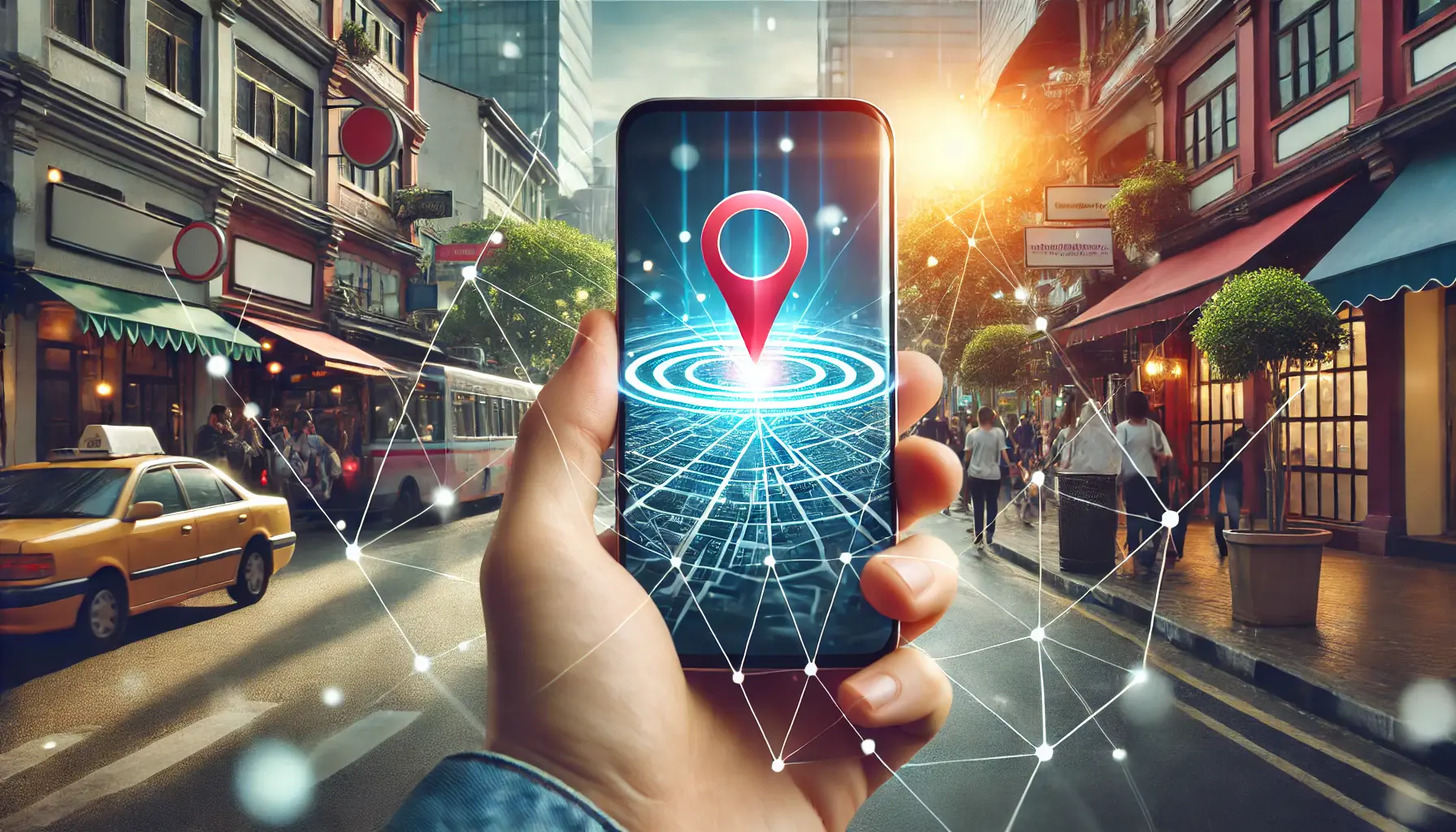
Geo-targeting concept illustrated through a smartphone showing a map with a location pin in a bustling urban scene.
1. Geo-Targeting: Reaching Your Local Audience Effectively
Geo-targeting is one of the most effective ways to ensure relevance of advertisements to local audiences.
By applying this technique, your advertising displays according to a user’s geographic location, thus bringing in concentrated campaigns.
- How It Works: Through geo-targeting, locations are determined via GPS, Wi-Fi, and cellular data, showing ads tailored to those locations.
- Benefits: With geo-targeting, you can reach customers near your store, advertise time-sensitive promotions, and reduce ad spend by narrowing your focus.
For example, a restaurant can use geo-targetingA marketing method that uses geographic information to deliver relevant advertisements. to send lunch discount notifications to users within a 2-mile radius during peak lunch hours.

undefined
2. Leveraging Social Media Ads for Mobile Engagement
Social media platforms like Facebook, Instagram, and TikTok are hotspots for mobile users.
Advertising on these platforms means using visually appealing and interactive content to reach your audience effectively.
- Video Ads: Short, engaging video ads can capture attention quickly and effectively.
- Story Ads: Immersive, full-screen ad experiences through platforms like Instagram and Facebook Stories.
- Audience Targeting: Detailed targeting based on interests, demographics, and behaviors helps deliver highly relevant ads.
By focusing on engaging formats and precise targeting, social media ads can significantly boost local mobile engagement.

In-app advertising for hyper-local campaigns, with interactive ads displayed on a mobile app in a bustling local area.
3. In-App Advertising for Hyper-Local Campaigns
In-app advertising places your messages directly within mobile apps that your target audience uses frequently.
This is the best method for hyper-local campaigns because it marries the power of mobile usage with precision in targeting.
- Popular Apps: Partner with local news apps, weather apps, or fitness apps that align with your audience.
- Interactive Ads: Use rich media ads, such as playable ads or interactive banners, to create a memorable user experience.
For instance, a local gym can advertise discounted memberships in a fitness tracking app to attract nearby users.

SMS marketing concept, with a person looking at an urgent SMS notification in a lively urban environment.
4. Using SMS Marketing to Drive Immediate Action
SMS marketing is a direct and personal way to reach your local audience.
With open rates as high as 98%, text messages are highly effective for driving immediate responses from customers.
- Time-Sensitive Offers: Send exclusive discounts or promotions that encourage immediate visits.
- Event Invitations: Use SMS to invite local customers to in-store events or sales.
- Personalization: Use the name of the recipient and include special offers to make messages more engaging.
For example, a boutique store can announce a flash sale to encourage people to visit the store within a few hours.
By integrating these four tactics, businesses can run robust mobile advertising campaigns that drive local engagement and deliver measurable results.
Implementing tactics like geo-targeting, social media ads, in-app advertising, and SMS marketing can transform your local promotions.

Optimizing Google Ads for local reach, with a person analyzing campaign metrics in a modern workspace.
Optimizing Your Google Ads Strategy for Local Reach
Google Ads is one of the most effective platforms for businesses aiming to increase their local reach.
With its powerful tools and targeting options, Google Ads allows businesses to connect with nearby customers and drive meaningful engagement.
Let’s explore how you can optimize your Google Ads strategy to achieve local advertising success.

Setting up geo-targeted campaigns in Google Ads, with a map interface highlighting specific regions for targeting.
Setting Up Geo-Targeted Campaigns in Google Ads
Geo-targeting is an important feature within Google Ads that helps you show ads to users within specific locations.
This ensures your budget is spent only on the most important audience for your business.
- Define Your Target Area: Use location settings in Google Ads to select specific cities, zip codes, or even a radius around your business.
- Exclude Irrelevant Locations: Prevent your ads from showing in areas outside your target market by excluding certain locations.
- Monitor Location Performance: Use performance reports to analyze which areas are delivering the best results and adjust your targeting accordingly.
For example, a local bakery can target users within a 5-mile radius and exclude locations that are too far for practical delivery.

Choosing the right keywords for local search, with a person analyzing keyword metrics in a modern workspace.
Choosing the Right Keywords for Local Search
Selection of keywords is crucial for the success of your Google Ads campaigns.
For local promotions, focus on keywords with location-specific terms and closely related to the services or products you offer.
- Use Long-Tail Keywords: Phrases like “best pizza in [city]” or “nearby plumber” are highly effective for local searches.
- Incorporate Location Names: Adding your city or neighborhood to your keywords helps your ads appear in relevant local searches.
- Leverage Negative Keywords: Exclude irrelevant terms to avoid wasting your budget on unrelated searches.
By fine-tuning your keyword strategy, you can ensure your ads are shown to the right audience in your local area.

undefined
Using Google Maps Ads to Attract Nearby Customers
Google Maps is essential for all local businesses.
By incorporating Google Maps ads into your campaigns, you can make it easy for customers to find and visit your business.
- Promoted Pins: Highlight your location on Google Maps with a special pin to attract more attention.
- Call-to-Actions: Add CTAs such as “Get Directions” or “Call Now” to encourage immediate engagement.
- Local Extensions: Add your address, phone number, and business hours directly to your ads to increase visibility and convenience.
For example, a local clothing store can use promoted pins to attract nearby shoppers and drive foot traffic.

Measuring and improving local campaign performance, with a focus on data analysis and optimization in a modern workspace.
Measuring and Improving Local Campaign Performance
Continuous improvement is key to running successful Google Ads campaigns.
Use analytics tools to measure the performance of your local campaigns and make data-driven adjustments.
- Track Key Metrics: Monitor impressions, clicks, and conversions to evaluate your campaign’s effectiveness.
- A/B Testing: Experiment with different ad creatives, headlines, and CTAs to identify what resonates best with your audience.
- Optimize Bids: Use location bid adjustments to allocate more budget to high-performing areas.
By regularly studying the data of your campaign, you will be able to fine-tune your Google Ads strategy for maximum local impact.
These optimizations will help you take full advantage of Google Ads to build a stronger local presence, attract nearby customers, and achieve real results.
Geo-targeted campaigns and keyword optimization ensure that your Google Ads effectively connect with your local audience.

Creative mobile advertising ideas for standing out locally, with interactive ads and engaging features in a lively urban environment.
Creative Mobile Advertising Ideas to Stand Out Locally
In a competitive local market, creativity can set your business apart and drive meaningful engagement.
Mobile advertising offers various tools and platforms that enable you to create innovative campaigns tailored to your local audience.
Here are some creative ideas to help your mobile advertising stand out.
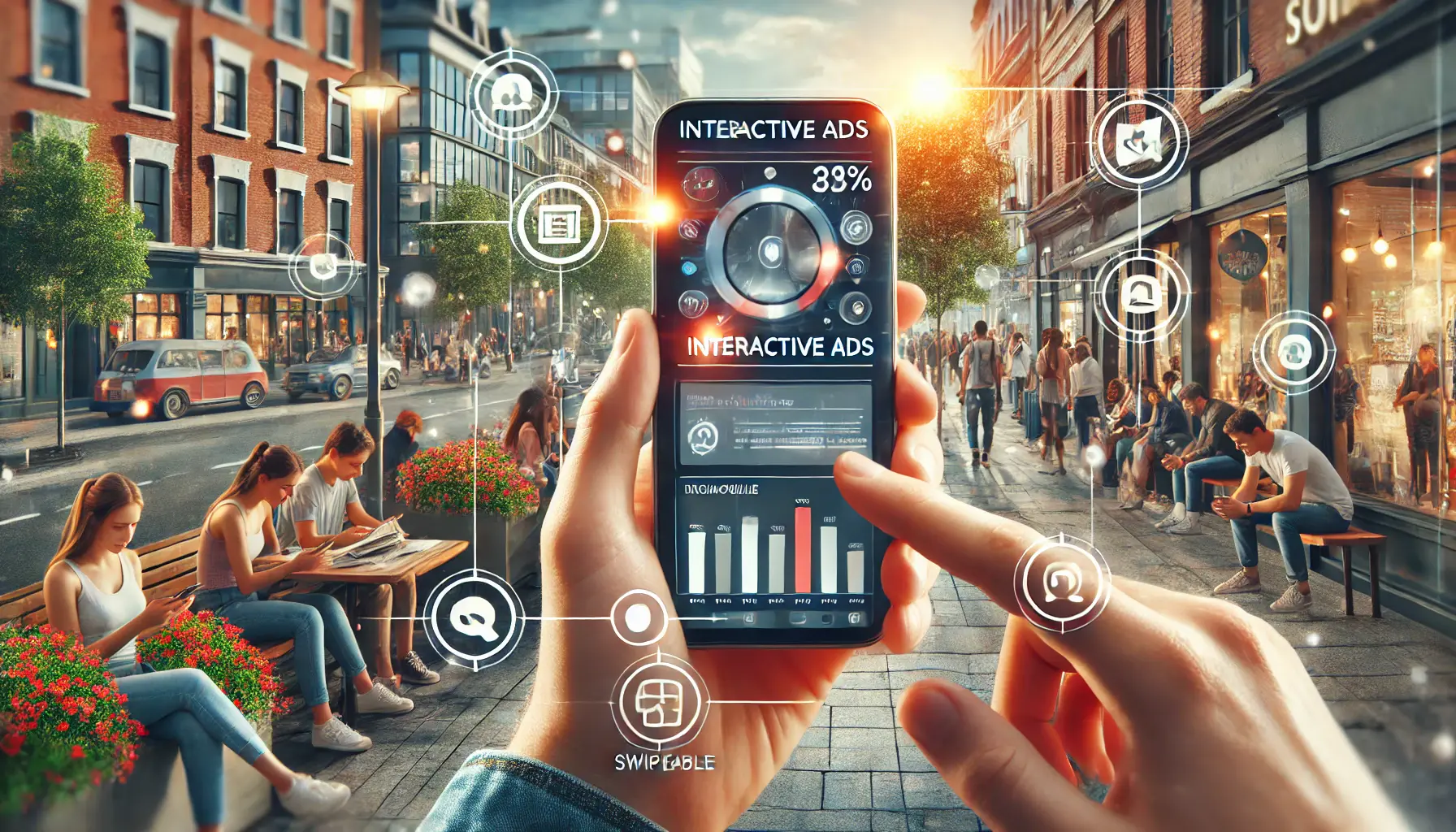
Running interactive ads to engage mobile users, with a person interacting with an engaging ad in a dynamic urban environment.
Running Interactive Ads to Engage Mobile Users
Interactive ads provide a great way to capture attention and keep users engaged.
These ads encourage users to take an active role in their experience, creating a memorable and impactful activity.
- Playable Ads: Let people play with a mini-version of your product, such as a game or a feature demo, before they commit.
- Polls and Quizzes: Use short quizzes or polls to involve users and learn something about their preferences.
- Swipeable Ads: Create ads where users can swipe through different offers or product features for a dynamic experience.
For example, a local fitness center can use a quiz to recommend workout classes based on user preferences, making their ad more engaging and useful.

Collaborating with local influencers for promotions, with a person and influencer engaging in a trendy local business environment.
Collaborating with Local Influencers for Promotions
Partnering with local influencers is a powerful way to amplify your mobile advertising efforts.
Influencers have garnered trust from their audiences, and their endorsements tend to be quite effective.
- Micro-Influencers: Partner with influencers maintaining a smaller but highly active local following.
- Exclusive Offers: Provide unique discount codes or special offers that influencers can promote to their audience.
- Event Collaborations: Host events with influencers and use mobile ads to promote attendance.
For instance, a local boutique can collaborate with a fashion influencer to showcase new arrivals through engaging Instagram Stories or TikTok videos.

Utilizing augmented reality (AR) in mobile ads, with a person interacting with a 3D model of a product in a modern setting.
Utilizing Augmented Reality (AR) in Mobile Ads
AR technology offers a unique way to create immersive experiences for your audience.
Integrate AR into your mobile ads to make your campaigns more interactive and memorable.
- Virtual Try-Ons: Let customers try on products like sunglasses or clothes using their phone camera.
- Interactive Environments: Place your products in the user’s real-world environment with AR, such as furniture in the living room.
- Gamified Ads: Create AR-based games that incorporate your products or brand elements.
A local furniture store, for example, can let users visualize how a sofa would look in their home using an AR ad.

undefined
Creating Limited-Time Offers for Mobile Users
Limited-time offers are a great way to create urgency and drive immediate action.
Mobile advertising allows you to deliver these promotions directly to your audience in real time.
- Push Notifications: Send notifications about flash sales or discounts to nearby users.
- Countdown Ads: Include a countdown timer in your ad to emphasize the urgency of the offer.
- Exclusive Mobile Deals: Offer discounts that are only accessible through mobile devices.
For example, a local restaurant can run a “happy hour” promotion with a countdown timer to attract nearby diners.
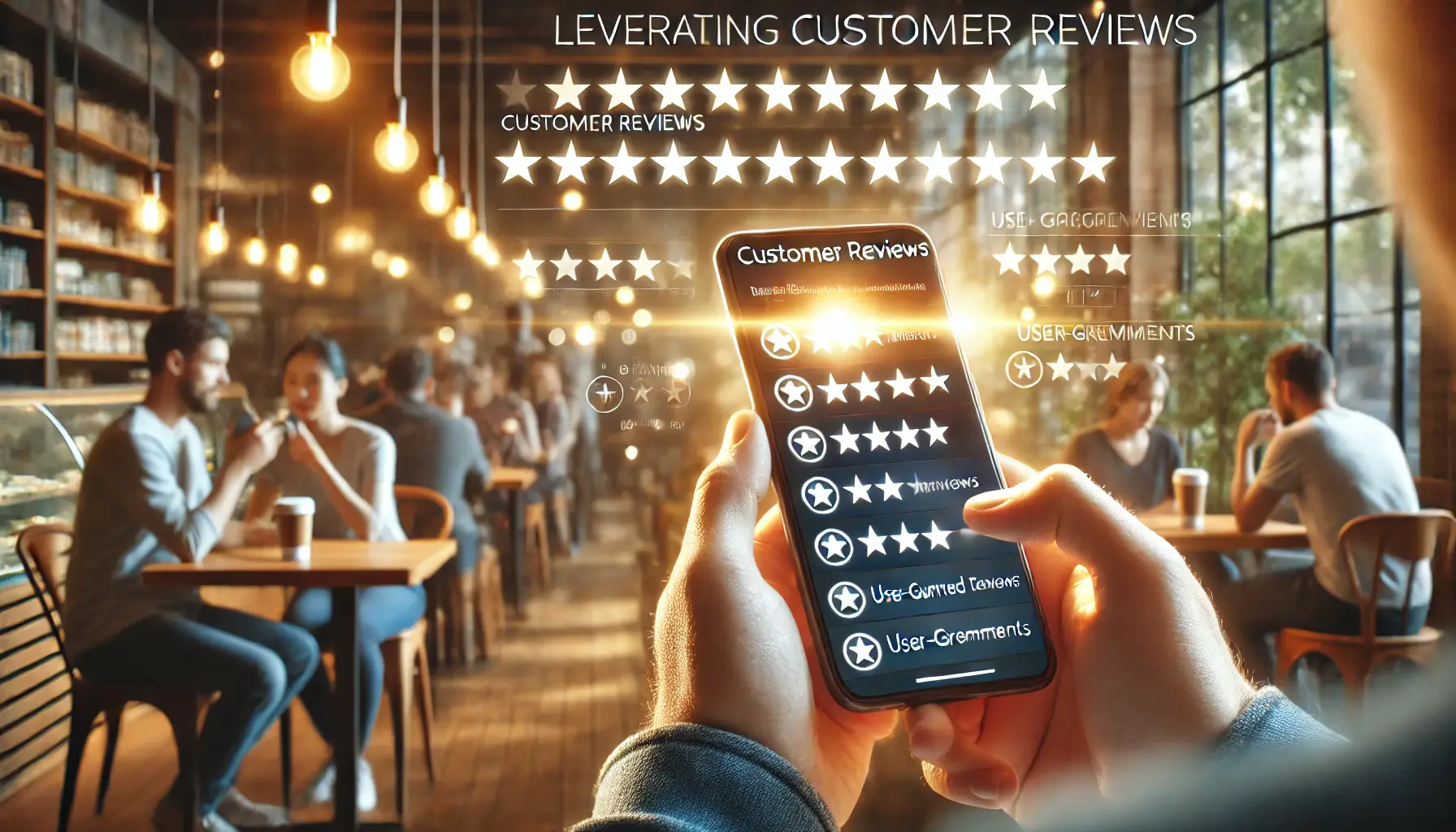
Leveraging customer reviews in mobile campaigns, with glowing reviews and star ratings visible on a smartphone in a vibrant store setting.
Leveraging Customer Reviews in Mobile Campaigns
Customer reviews have the immense power to build trust and credibility.
Highlighting positive reviews in your mobile ads can reassure potential customers and encourage them to take action.
- Testimonial Ads: Highlight quotes from satisfied customers in your ad creatives.
- Ratings Highlight: Showcase high ratings of your business on Google or Yelp.
- User-Generated Content: Use customer-generated photos or videos in your ads to make them look more realistic.
For example, a local spa can showcase glowing reviews of satisfied customers in its ads to gain new clients.
By integrating these creative ideas, your mobile advertising campaigns will capture attention, engage your local audience, and drive real results.
Creative strategies like interactive ads, influencer collaborations, and AR experiences can make your mobile advertising memorable and engaging.
Tracking and measuring success in local mobile advertising, with performance metrics and analytics tools displayed on a laptop screen.
Tracking and Measuring Success in Local Mobile Advertising
Tracking and measuring the success of your mobile advertising campaigns is crucial to achieving long-term results.
Without proper monitoring, it’s impossible to know what’s working and where improvements are needed.
By leveraging the right tools and metrics, you can fine-tune your strategies to maximize the impact of your local mobile advertising efforts.
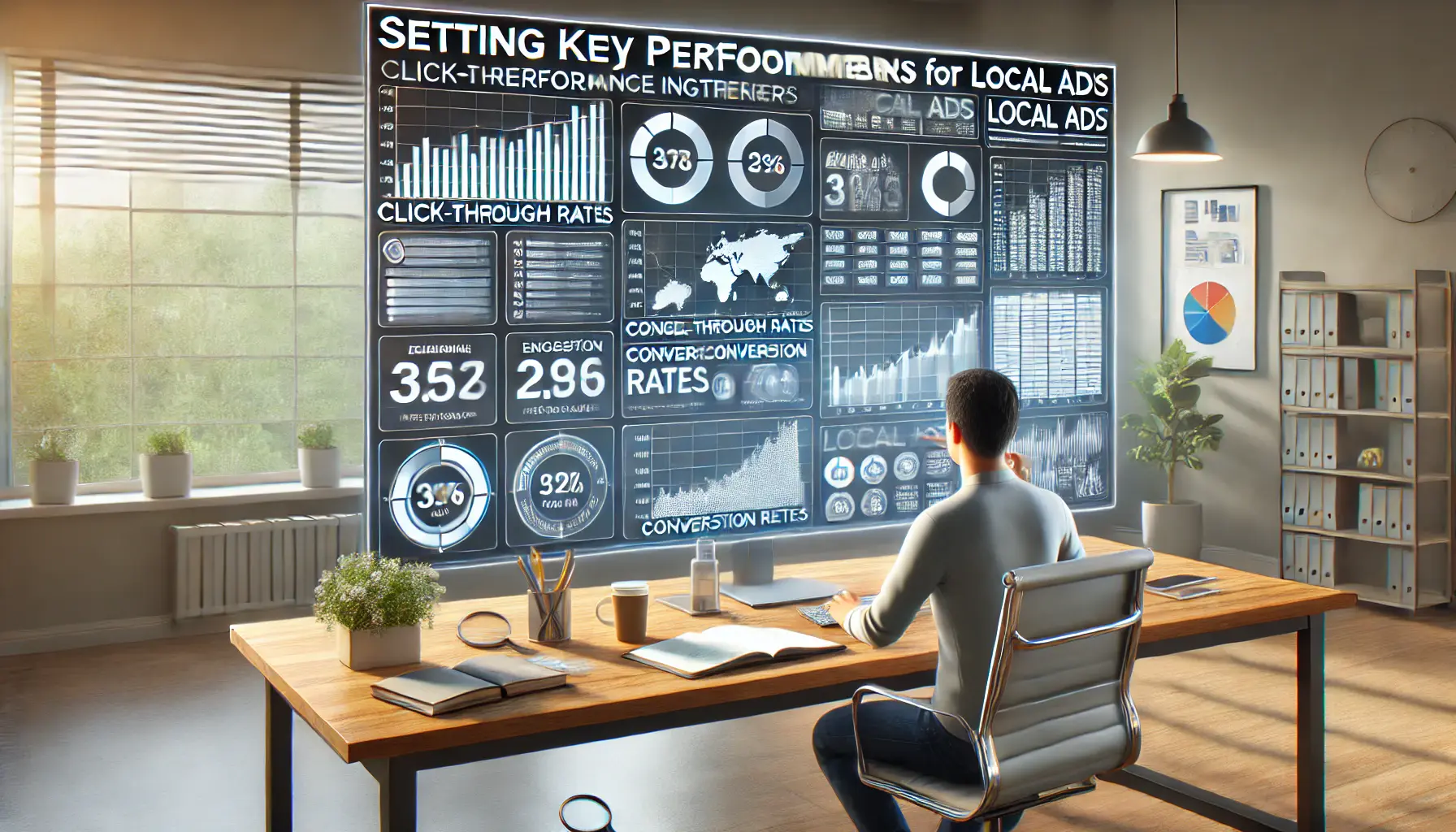
Setting key performance indicators (KPIs) for local ads, with a focus on performance metrics in a professional workspace.
Setting Key Performance Indicators (KPIs) for Local Ads
Defining clear KPIs is the first step to effectively measuring the success of your campaigns.
KPIs help you focus on specific goals and track your progress.
- Click-Through Rate (CTR): Measures how many users clicked on your ad compared to how many saw it, providing insights into its appeal.
- Conversion Rate: Tracks the number of users who completed an intended action such as making a purchase or signing up.
- Cost-Per-Click (CPC): Shows the cost efficiency of your ads by calculating how much you spend per click.
- Return on Ad Spend (ROAS): Evaluates the revenue generated for every dollar spent on ads, helping you determine profitability.
By setting and monitoring these KPIs, you can gauge the effectiveness of your local mobile advertising efforts.

Using tools to analyze mobile advertising campaigns, with a focus on campaign data and performance metrics in a modern workspace.
Tools to Analyze Mobile Advertising Campaigns
Using the right analytics tools can provide valuable insights into your campaigns’ performance.
These tools help you gather data, identify trends, and make informed decisions.
- Google Analytics: Tracks user behavior and engagement across your website and mobile campaigns.
- Facebook Ads Manager: Provides in-depth analytics on mobile ad performance on social media platforms.
- App Analytics Tools: Platforms like Adjust and AppsFlyer offer insights into app-specific campaigns, including installs, user activity, and in-app behavior.
- Heatmap Tools: Tools like Hotjar show areas of your landing page that retain the most user activity, guiding you toward optimization.
These tools help you analyze what is working and where you need to make adjustments to improve campaign results.

Understanding mobile ad analytics to make better decisions, with a person analyzing detailed performance data on a large screen.
Understanding Mobile Ad Analytics to Make Better Decisions
Analytics data is useful only when you know how to interpret it.
Understanding key metrics and patterns in data can guide your decision-making and further improve your campaign strategies.
- Identify Trends: Watch for patterns in user behavior, such as the best time of day for high engagement.
- Analyze Audience Segments: Understand which demographics respond best to your ads and tailor future campaigns accordingly.
- Optimize Ad Placements: Determine which platforms and placements yield the highest ROI.
Interpreting analytics effectively helps you make data-driven decisions and refine your mobile advertising approach.

Using heatmaps to track local engagement in mobile advertising, with areas of high user interaction displayed on the screen.
Using Heatmaps to Track Local Engagement
Heatmaps are a powerful way to visualize how users interact with your mobile ads and landing pages.
They show where users click, scroll, and spend the most time.
- Click Maps: Highlight the areas of your ads or pages that receive the most clicks.
- Scroll Maps: Show how far users scroll down your pages, revealing whether your content captures attention.
- Session Replays: Replay individual user sessions to gain deeper insights into their behavior.
For example, a local café can use heatmaps to determine which menu items or promotions generate the most interest.

Iterating campaigns based on performance metrics, with data analysis and optimization adjustments in a clean workspace.
Iterating Campaigns Based on Performance Metrics
Continuous iteration is key to maintaining successful mobile advertising campaigns.
Regularly reviewing performance metrics and making adjustments ensures your campaigns stay effective over time.
- Test New Creatives: Experiment with different ad visuals, headlines, and calls-to-action to see what resonates best.
- Adjust Targeting: Refine your audience targeting based on engagement data to reach the right customers.
- Reallocate Budgets: Allocate more resources to high-performing ads and scale back on underperforming ones.
By iterating based on data, you’ll be able to optimize your mobile advertising campaigns for even better results for your local business.
Having the right KPIs, tools, and continuous improvements in place lets you confidently track and measure your mobile advertising success as it drives meaningful engagement and achieves your business objectives.
Set clear KPIs, use analytics tools, and iterate campaigns to ensure continuous improvement and measurable success in local mobile advertising.
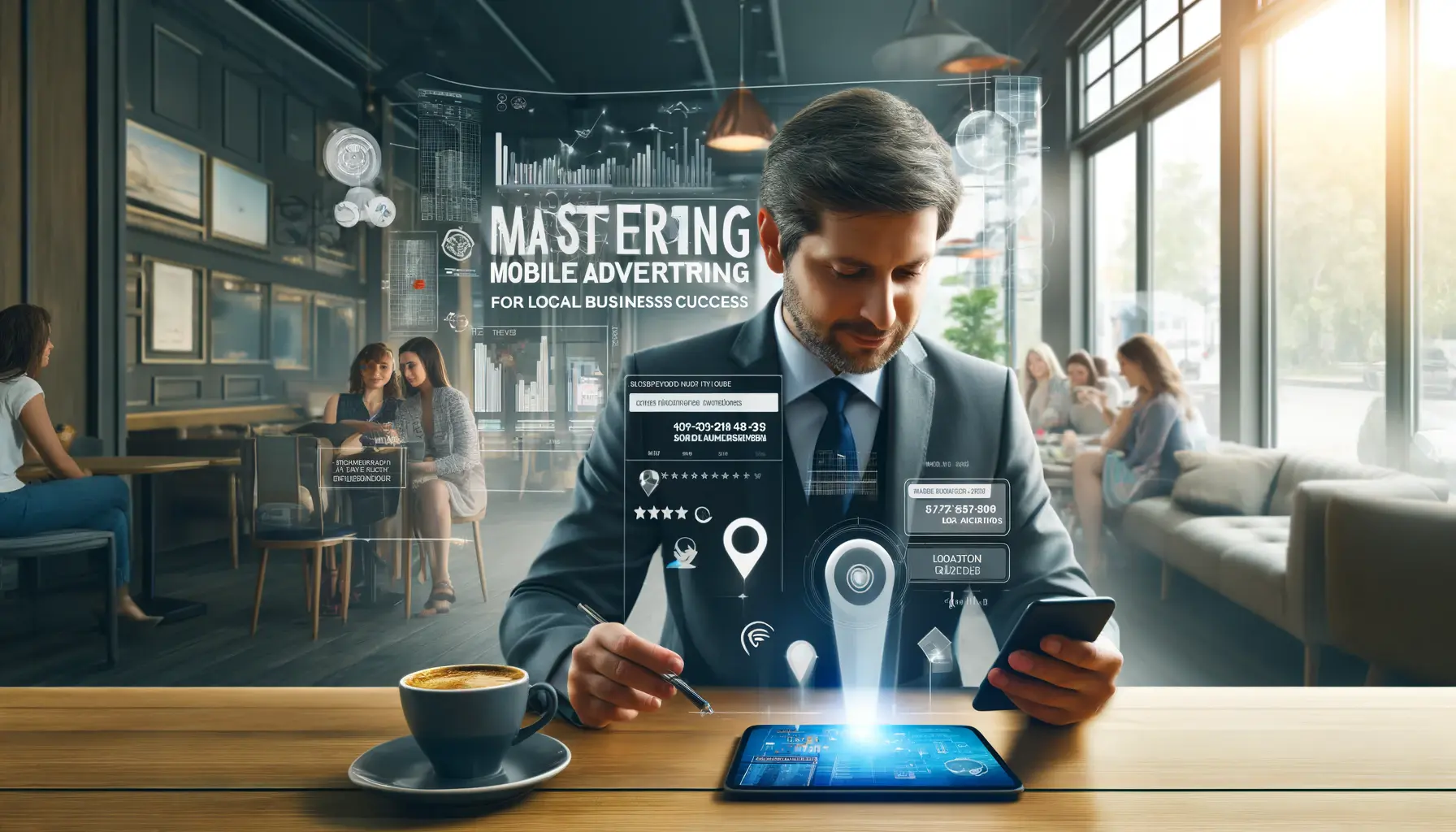
Mastering mobile advertising for local business success, with a business owner analyzing mobile ads in a dynamic local environment.
Mastering Mobile Advertising for Local Business Success
Mobile advertising has become an essential strategy for local businesses to connect with their audience and thrive in today’s competitive marketplace.
By leveraging mobile-focused tactics, optimizing platforms like Google Ads, and employing innovative and creative approaches, businesses can achieve significant growth and engagement.
Let’s recap the key strategies discussed in this article and how they contribute to a successful mobile advertising campaign.

undefined
Key Takeaways from Effective Mobile Advertising Strategies
To dominate your local market, it’s important to focus on these core areas of mobile advertising:
- Geo-Targeting: Use location-based targeting to ensure your ads reach the right audience at the right time, maximizing relevance and effectiveness.
- Creative Campaigns: Incorporate interactive ads, influencer partnerships, AR technology, and limited-time offers to engage and attract local customers creatively.
- Google Ads Optimization: Create geo-targeted campaigns, select location-based keywords, and run Google Maps ads to extend your visibility and drive more local users to you.
- Tracking and Analytics: Establish clear KPIs, use tools such as Google Analytics and heatmaps, and iterate on performance data constantly to refine your approach.
The power of tracking and measuring success in mobile advertising, with a person analyzing campaign data in a professional office setting.
The Power of Tracking and Measuring Success
Effective mobile advertising doesn’t stop at launching a campaign—it requires ongoing analysis and optimization.
Setting clear KPIs like click-through rates, conversion rates, and return on ad spendA metric that calculates the revenue generated for every dollar spent on advertising. ensures your campaigns are delivering measurable results.
Tools like heatmaps and session replays offer valuable insights into user behavior, helping you adjust your strategies for maximum impact.

undefined
Why Creativity is Key to Mobile Advertising
Incorporating creativity into your campaigns is essential to stand out in a crowded local market.
Interactive ads, AR experiences, and collaborations with local influencers not only engage your audience but also build trust and credibility.
These approaches create a lasting impression and encourage users to take action.
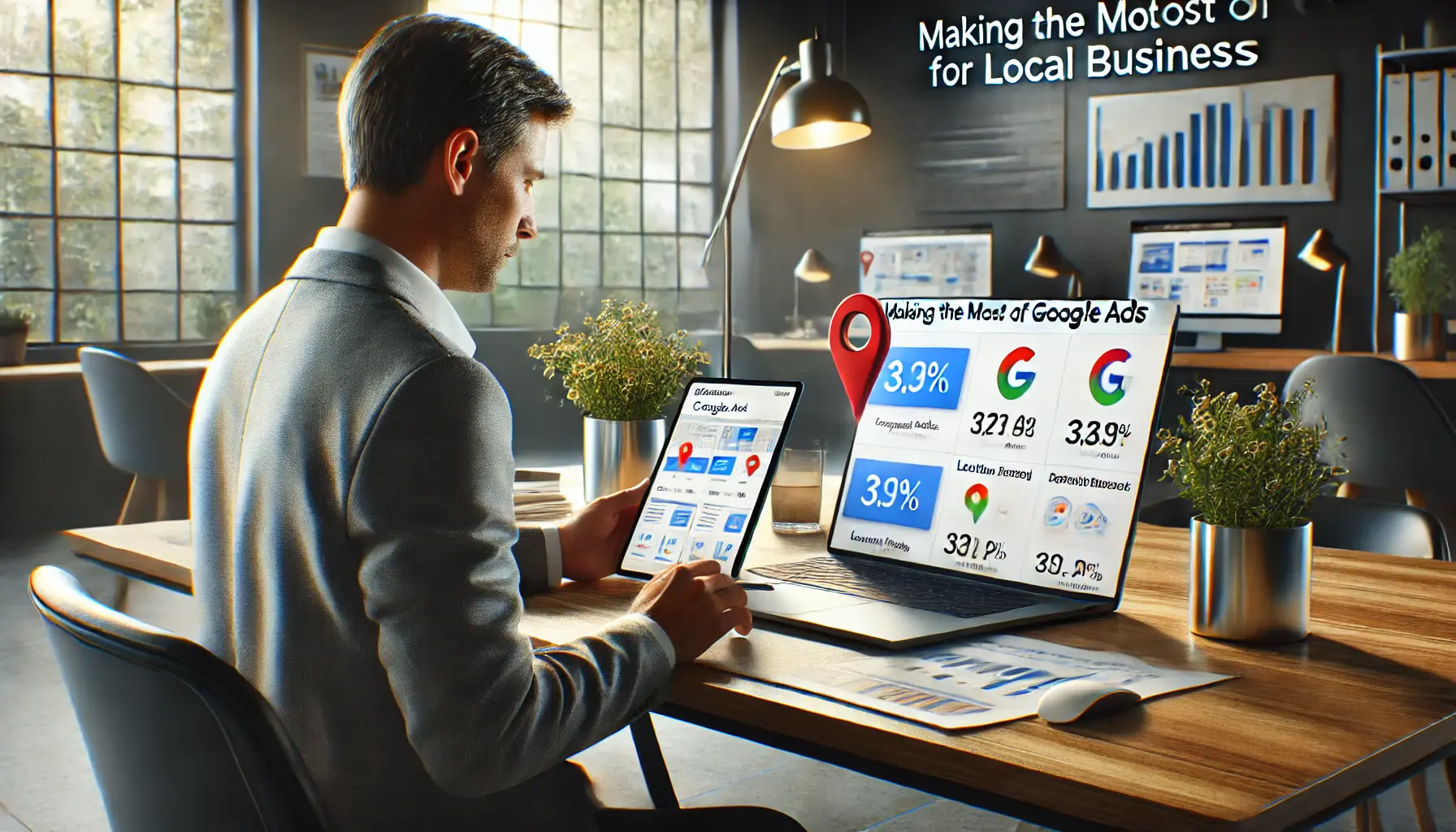
Making the most of Google Ads for local businesses, with a business owner reviewing Google Ads campaign data in a professional workspace.
Making the Most of Google Ads for Local Businesses
Google Ads provides unparalleled opportunities for local businesses to connect with nearby customers.
Whether through geo-targeting, keyword optimization, or Google Maps ads, this platform enables businesses to effectively reach their audience and drive traffic.
Combining these features with data-driven adjustments ensures continuous improvement and success.

undefined
Final Thoughts on Mobile Advertising
Mastering mobile advertising is all about strategy, creativity, and continuous adaptation.
By paying attention to location-based targeting, innovative ad formats, and performance tracking, a local business can build strong relationships with its audience and achieve measurable growth.
Mobile advertising is more than just a tool—it’s a strong driver of success in the digital age.
Combining creative tactics, optimized tools, and consistent measurement is the key to mastering mobile advertising for local growth.

Frequently asked questions about mobile advertising, with a person analyzing data and insights on a tablet in a professional workspace.
Your campaigns can be managed by an agency specialized in Google Ads, check out our service page.
Frequently Asked Questions About Mobile Advertising
Mobile advertising is a multi-dimensional yet effective tool for local businesses.
Below are some of the most commonly asked questions to help you better understand its value and how to use it effectively for local promotions.
Mobile advertising is the process of promoting products or services on mobile devices through apps, websites, and messaging.
It leverages targeting tools like location data and user preferences to deliver personalized and relevant ads.
Mobile advertising allows local businesses to reach nearby customers in real time, build engagement through targeted campaigns, and drive foot traffic with precise location-based promotions, ensuring relevance and cost-efficiency in ad spending.
You can use geo-targeting to specify locations, employ local keywords, and run ads on platforms like Google Maps and social media to focus on audiences within your preferred geographic area.
Interactive ads, AR-based ads, and local-specific campaigns such as push notifications and countdown offers work best.
These formats engage users and encourage immediate actions like visiting a store or making a purchase.
Measure success by tracking KPIs like click-through rates, conversion rates, return on ad spend, and user engagement metrics using tools like Google Analytics, Facebook Ads Manager, and heatmaps.
Key features include geo-targeting, keyword optimization with local terms, Google Maps ads, and the ability to measure performance through detailed analytics and reporting tools for precise campaign adjustments.
Creative campaigns using interactive ads, AR, and influencer partnerships build user engagement, trust, and credibility.
These innovative approaches make your campaigns more memorable and encourage higher user participation and conversions.
Tools like Google Analytics, Facebook Ads Manager, and heatmap software such as Hotjar provide valuable insights into ad performance, helping you refine strategies and optimize future campaigns for better results.
Use geo-targeting to send location-based promotions, employ Google Maps ads for easy navigation, and leverage limited-time offers through push notifications to encourage nearby customers to visit your business location.










